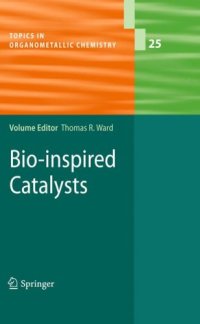
Ebook: Bio-inspired catalysts
- Genre: Chemistry
- Tags: Organometallic Chemistry, Catalysis, Biochemistry general, Inorganic Chemistry, Medicinal Chemistry
- Series: Topics in organometallic chemistry 25
- Year: 2009
- Publisher: Springer-Verlag Berlin Heidelberg
- City: Berlin
- Edition: 1
- Language: English
- pdf
In order to meet the ever-increasing demands for enantiopure compounds, heteroge- ous, homogeneous and enzymatic catalysis evolved independently in the past. Although all three approaches have yielded industrially viable processes, the latter two are the most widely used and can be regarded as complementary in many respects. Despite the progress in structural, computational and mechanistic studies, however, to date there is no universal recipe for the optimization of catalytic processes. Thus, a trial-and-error approach remains predominant in catalyst discovery and optimization. With the aim of complementing the well-established fields of homogeneous and enzymatic catalysis, organocatalysis and artificial metalloenzymes have enjoyed a recent revival. Artificial metalloenzymes, which are the focus of this book, result from comb- ing an active but unselective organometallic moiety with a macromolecular host. Kaiser and Whitesides suggested the possibility of creating artificial metallo- zymes as long ago as the late 1970s. However, there was a widespread belief that proteins and organometallic catalysts were incompatible with each other. This severely hampered research in this area at the interface between homogeneous and enzymatic catalysis. Since 2000, however, there has been a growing interest in the field of artificial metalloenzymes for enantioselective catalysis. The current state of the art and the potential for future development are p- sented in five well-balanced chapters. G. Roelfes, B. Feringa et al. summarize research relying on DNA as a macromolecular host for enantioselective catalysis.
With the aim of complementing well-established catalytic strategies for enantioselective catalysis, the field of artificial metalloenzymes has attracted increasing interest in the past decade. Artificial metalloenzymes result from the incorporation of a catalytically active organometallic moiety within a macromolecular host. Localization of the competent metal is ensured either by covalent, dative or supramolecular anchoring in either DNA or a protein scaffold. The properties of the resulting hybrid catalysts combine attractive features of both homogeneous and enzymatic catalysis. In particular, the optimization of such systems can be achieved both by chemical and genetic means. The book, consisting of five chapters written by leading experts, critically summarizes the state of the art in enantioselective epoxidation, sulfoxidation, fluorination, hydrogenation, allylic alkylation, Diels-Alder cycloadditions as well as Michael additions catalyzed by artificial metalloenzymes. This timely review unambiguously demonstrates the compatibility and complementarity of organometallic and enzymatic catalysis.